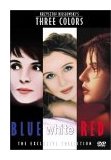

|
| weblog/wEssays | home | |
|
Blue: Love and Loss (October 8, 2005)  To avoid pontificating about what makes a "great film" I am starting a list of "interesting films," which make this modest claim: if you are a serious fan of films, then you will certainly find much of interest in these films. (For a list of movies which have merit in my view, check out reviews.) My initial entry is "Blue" (Bleu), the first film in Krzysztof Kieslowski's Three Colors Trilogy (Blue / White / Red) Unusual in film of any era, Kieslowski also uses sound as a thematic transition, invoking the main character's memories not as visual images of her dead husband and daughter but as minor-chord representations of her loss. (Her husband was a famous composer, and she's no slouch at writing a score, either.) At these junctures, the soundtrack of ambient noise--her splashing around a pool, for instance--is suddenly overwhelmed with powerful orchestral music in a minor key. As the sound swells the screen goes black, as if her visual sense has been similarly overwhelmed by memories of the people and life she has lost. While the death of my own sister in a car crash of the same sort that kills Julie's (Juliette Binoche) family no doubt adds to the film's personal meaning, I think its depiction of the loss resulting from the death of loved ones is universal. In the film, Julie tries to evade her grief by denying all connections to people or things: she abandons her gloriously medieval stone home and everything inside it except one kitschy lamp, and refuses contact with neighbors, family and most intimately, with a man who confesses he has secretly loved her for years. We can all grasp the emotional appeal of cutting off memories, relationships and meanings; in the depths of her profound alienation from life, Julie's character states that "nothing is important." But as the movie unfolds, we see through Julie that such emotional distance is impossible to maintain; Julie forms bonds with a call-girl in her building, and with a mouse whose presence frightens her in a child-like way. The themes of loss are multiple; Julie's mother suffers from dementia, reflecting the loss of meaning and memory. She discovers that her husband had a secret mistress, who is now pregnant with the dead man's child--a painful irony to Julie which heightens the loss of her own child and piles yet another loss on her: the destruction of her husband's fidelity to her in life. Julie also rejects music and the creative energy of life, refusing to help her husband's colleague (the man who has secretly loved her for many years) finish the important score her husband was working on at his death. This denial of public self, of ambition, of talent and of art is part and parcel of her rejection of all ties to life; she destroys what she believes is the only copy of her husband's unfinished masterpiece. But when a copy of the work turns up in the colleague's hands, he attempts to finish it more as a recognition of its importance than as an expansion of his admittedly weak talents. Somehow she cannot let the work be completed in a mediocre fashion, and so she begins writing the ending as she knew her husband had intended it. Her renewal finds full voice when the colleague/lover insists that she take public credit for the work. With the musical bond between them established, she gives in to the love he offers her. There are quibbles, of course, as there is with any art; it is certainly easier to overcome grief when you have enough money for a splendid top-floor flat in Paris, and a talented, handsome character is madly in love with you. The connection between a street flautist and her replacing the trumpet with a flute in the final score is perhaps too artful; but many other scenes are anachronistic and unforced, much like life itself. The dialogue is sparse, naturalistic, telling; Binoche does a wonderful job evoking a spirit-shattering grief. There is mystery in the film--some of which is illuminated later in the film, some of which is left as detritus from chance encounters--but whatever is not explained is thematically related as opposed to art-house contrived. To explain the difference, I'll look at another interesting but not quite as moving film next: Suzhou River A great film stays with you, not just as a series of striking visual images, but as a satisfying unfolding of characters and situations which feel emotionally real. The cliche in Hollywood circles is "I'm good with story," and this explains why most Hollywood films are forgettable: story is "rien" (nothing), character is everything, and you cannot plot out a character in the same cookie-cutter fashion as you can a story line. In a great film, the characters come across as whole beings, while in mediocre movies they are nothing but pieces assembled without any deeper understanding of the character by the screenwriter. In mediocre films, we are left not with the sense of an authentic person but with annoying holes and disconnects--all the nagging parts which simply don't fit together in a person's behavior, motivation, crisis and response. "Blue" exemplifies this authenticity of character, and this is why it's a great film. Oops, I mean an interesting film. * * * copyright © 2005 Charles Hugh Smith. All rights reserved in all media. I would be honored if you linked this wEssay to your site, or printed a copy for your own use. * * * |
||
| weblog/wEssays | home |